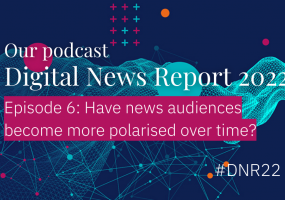How are European digital-born outlets funding quality digital journalism with no legacy brand?
13 Jan 2017
By Emma Goodman
A report from the Reuters Institute finds that the challenges digital-born media are tackling are surprisingly similar to those faced by legacy media, including finding the best ways to fund their journalism. The report, Digital-born News Media in Europe, focuses on 12 digital-born news outlets in France, Germany, Spain, and the UK, including the four national editions of the Huffington Post, all of which operate in competitive markets with little tradition of paying for digital news. Aside from the Huffington Post, the news outlets studied are founded by individuals – usually journalists, rather than tech industry players. They are driven by a journalistic mission rather than focused on making money or specifically furthering digital innovation: they are born digital because it makes sense in these countries today, rather than because they are trying to develop technical innovations as such. Funding remains a challenge across the outlets. Barriers to entry are clearly far lower online compared with print or broadcast and allow for more experimentation, but it is still expensive to produce good online content, which requires substantial investment in both reporting time and in production. Many legacy outlets subsidise their digital operations from their print or broadcast products. So how are digital-born outlets establishing themselves and surviving with no legacy revenues to fund their digital operations? The report identifies three different funding strategies for European digital-born news outlets: advertising, subscriptions, and donations, although it is important to note that these are not mutually exclusive, and most media are pursuing more than one source of funding and trying to diversify revenue by testing new initiatives. Advertising Digital-born news organisations that rely on advertising as their main source of revenue need, as legacy media have traditionally done, to aim for wide reach. They produce more content that covers a wider range of topics than subscription and donation-funded sites, the report finds. Aside from the Huffington Post, the most clearly advertising-focused news outlets studied are both Spanish, and large compared with the other news media studied. El Confidencial has 100 journalists and 2.9m monthly unique users, while El Espanol, founded just last year, has 70 journalists and 1.1m monthly unique users. El Confidencial says that ‘economic freedom and profitability’ are its advantage over competitors and its executive director Alberto Arturo told researchers that “we’re making money.” Even so, given the pressure that display ad rates are under, the digital-born sites that rely primarily on advertising are making an effort to move away from programmatic banner ads by investing in native advertising and online video ads. Native advertising (or branded content) is a fast-growing sector in Spain, both El Confidencial and El Espanol said, but comes with its own challenges. It can be expensive to produce, it has potential for confusion with journalistic content, and has to be the right fit for the news media’s brand. Subscriptions Mediapart, founded in France in 2008 by a group of journalists including Edwy Plenel, former editor-in-chief of Le Monde, sees relying on subscription revenue as the only way to be truly independent. The site carries no advertising, with content behind a hard paywall only accessible to its members. Having started with a goal of 50,000, it now has almost 130,000 paying subscribers and was cited by others interviewed for the report as inspiration for subscription models. Subscription sites, which have better odds of success outside the highly competitive English language market, need to be telling stories that others aren’t to differentiate themselves from the free competition. Mediapart co-founder Francois Bonnet told researchers that publishing scoops was key to building subscriptions. “Yesterday we published a huge scoop on Sarkozy, and got 300 new subscriptions,” he said. Mediapart has 40 journalists and could definitely be seen as a niche publication, but it has built a strong brand in the areas it covers. “Our competition is Le Monde, Libération, Le Figaro, Les Échos when it comes to some economic investigations,” Bonnet said. Non-profits Rather than focusing on building a business model, non-profits that are funded by donations can (and must) focus primarily on the impact of their work, as this is generally what donors seek to support. Both the Bureau of Investigative Journalism in the UK and Germany’s Correctiv (with a similar focus on investigative journalism) started with big multi-million pound/euro grants, and it would be hard to get off the ground without that, the Bureau’s managing editor Rachel Oldroyd says. Once you have established yourself it becomes easier to seek funding for journalism covering specific areas, she adds. Both non-profits studied make some additional revenue via syndicating their content, but it is a limited amount, and the potential for impact is more important than the sums involved, Oldroyd explains in the report. This is a key difference between non-profit and for-profit news media: non-profits produce traditional journalism but seek to collaborate with and use the weight of legacy media to increase the reach, and hopefully the impact of their work. Its key distribution strategy is through other media rather than their own website. Therefore although digital-born, their work appears on other media also. Nonprofit news organisations have a long tradition in the US, and have seen a flood of donations since the November 8 presidential election. Europe does not have the same philanthropic tradition, however, and although the two outlets studied have been successful in securing multi-year funding, it is not permanent. Conclusion As the authors note, digital-born outlets are more prominent in terms of reach in France and Spain, markets where legacy media are weaker, compared with the UK and Germany where legacy media are stronger. But none of the news organisations studied for the report felt that they had found a permanently sustainable model for funding digital news production. “The experience so far suggests that the digital news business is far from lucrative,” researchers comment, but the mission-driven digital-born sites seem happy with survival as a key goal, continuing the trend highlighted by the 2012 report on European news start-ups ‘Survival is Success.’





